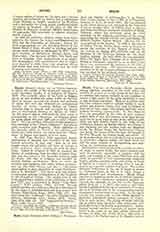

Baysio (BAISIO), GUIDO DE, an Italian canonist, b. about the middle of the thirteenth century of a noble Ghibelline family; d. at Avignon, August 10, 1313. The probable place of his birth is Reggio, where he also studied law under Guido de Suzaria. Here he became, successively, doctor and professor of canon law and also obtained an ecclesiastical benefice as canon. Gerhard, Bishop of Parma, attached him to himself and remained his patron also as Cardinal–Archbishop of Sabina (d. 1302). To this patron Baysio dedicated his chief work, a commentary on the “Decretum” of Gratian, which he wrote about the year 1300 and entitled “Rosarium”. It is an excellent collection of older glossaries, not contained in the “Glossa Ordinaria”, and principally compiled from Huguccio. Many additions to the glossary which are found in the editions published since 1505 (Paris), are taken from the “Rosarium” of Baysio and appear over his name.
In 1296 Pope Boniface VIII appointed Baysio Archdeacon of Bologna and chancellor of the celebrated university in that city. Here he at first taught canon law privately and later on became a public professor, which position he held for three years. Called to Avignon in 1304 he retained the dignity of archdeacon, held the office of papal chaplain, and also served in the Apostolic chancery until his death. His stay at Avignon was marked by several literary productions. Here he wrote an accurate and complete, but rather diffuse, commentary on the Liber Sextus and also a “Tractatus super haeresi et aliis criminibus in causa Templariorum et D. Bonifacii”. This latter work was written in connection with the condemnation of the Templars at the Council of Vienne. The second part of the work constitutes a defense of the orthodoxy of Boni-face VIII, and is published in Mansi, “Coll. Sacr. Concil.”, XXV (Venice, 1782), 415-426. Having held the position of archdeacon, Baysio is of ten known by the name of Archidiaconus and thus quoted (see Ferraris, Bibliotheca, Rome, 1892), VIII, 271. His chief work, the “Rosarium”, has gone through many editions: Strasburg, 1472; Rome, 1477; Venice, 1480; 1513; 1601, etc. The “Apparatus ad Sextum”, Milan, 1480; Venice, 1577.
LEO GANS

